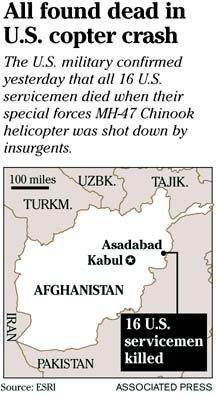Victims in
Afghan crash
had local ties
As many as six SEALs
from Pearl Harbor may
have been passengers
The deaths of as many as six elite Pearl Harbor Navy SEALs in a Chinook helicopter crash Tuesday could be the worst single-day combat loss in Afghanistan for the islands since the United States ousted the Taliban government in 2001.
![]()

There has been no official confirmation of reports that the Pearl Harbor SEALs were passengers, along with two other SEAL members and eight Army air crew members, but notification was made to at least one island family Wednesday night.
"We have recovered all 16 bodies of those servicemen who were on board," Marine Lt. Gen. James Conway, the Joint Staff's operations director, told reporters at a Pentagon briefing yesterday. Original reports had said 17 service members were on the aircraft.
Positive identification of the deceased as well as family notification is ongoing, Conway said.
"We do extend our sincere condolences to the families and friends of those service members involved in this incident," he said.
The Pentagon yesterday said the MH-47 helicopter was shot down by insurgents using a rocket-propelled grenade in eastern Afghanistan at Asadabad near the Pakistani border.
Conway and Pentagon spokesman Lawrence Di Rita told reporters that no U.S. military members involved in the operation have been classified as missing at this point. Two MH-47 twin rotor helicopters -- a variant of the Army's CH-47 Chinook -- were sent to the area to bring reinforcements to 1,000 U.S. troops involved in a firefight.
Although SEALs are experts at waterborne combat missions, they are also specialists in land warfare operations, especially at small-unit infantry tactics.
In Iraq, Marines from Kaneohe also were involved in the worst single-day loss when 26 Marines and one Navy corpsman from Pearl Harbor were killed in the crash of a CH-53E Super Stallion helicopter on Jan. 26. It also was the worst single-day incident for the Marine Corps since the 1983 Marine barracks bombing in Beirut.
Before Tuesday's incident, 22 soldiers, two sailors, 42 Marines and one civilian with Hawaii ties had been killed in Iraq since the war started on March 19, 2003.
One soldier was killed in Kuwait last year.
Fifteen other 25th Division soldiers were killed in Afghanistan, as well as two Marines.
Other large single incident battle casualties involving service members with Hawaii ties:
» On Oct. 30, seven Marines of Kaneohe Bay's 1st Battalion, 3rd Marine Regiment were killed in Al Anbar province in Iraq when a suicide bomber drove into their convoy.
» On Nov. 27, in Afghanistan, three Schofield Barracks soldiers were killed in the mountains near Bamian when the CASA 212 aircraft they were in crashed. All three soldiers were assigned to Headquarters, Headquarters Troop, 3rd Squadron, 4th Cavalry Regiment. The families of the fallen soldiers have filed a federal suit against the civilian company that piloted the aircraft.
The Pearl Navy SEAL commandos, who come under the Special Warfare Command in San Diego, are a close-knit community.
Only on rare occasions are their clandestine operations open to the media. One such occasion occurred in May 2004 when the SEALs dedicated their new 22-acre Middle Loch facility.
The Navy allowed the media and special guests to examine one of the SEALs' special warfare operations tools: a battery-powered, 65-foot black minisub.
Called the Advanced SEAL Delivery System, the black cigar-shaped minisub, which weighs 60 tons, is big enough to accommodate up to 16 SEALs, including two operators who do not have to slip into scuba gear until they are ready to start their mission.
Two of Pearl Harbor's 17 Los Angeles-class nuclear attack submarines -- USS Greeneville and USS Charlotte -- have been modified to carry on their decks either the 65-foot minisub or a 35-ton, 39-foot-long dry-deck shelter.
The shelters are used to house smaller 22-foot-long, 2.5-ton torpedo-shaped submersibles, which also have a shorter range. Unlike the minisub, Navy SEALs using the smaller submersibles must wear scuba gear.
E-mail to City Desk
[News] [Business] [Features] [Sports] [Editorial] [Do It Electric!]
[Classified Ads] [Search] [Subscribe] [Info] [Letter to Editor]
[Feedback]
